Glycolysis is the metabolic process that serves as the foundation for both aerobic and anaerobic cellular respiration. In glycolysis, glucose is converted into pyruvate. Glucose is a six- memebered ring molecule found in the blood and is usually a result of the breakdown of carbohydrates into sugars. It enters cells through specific transporter proteins that move it from outside the cell into the cell’s cytosol. All of the glycolytic enzymes are found in the cytosol.
The overall reaction of glycolysis which occurs in the cytoplasm is represented simply as:
6H12O6 + 2 NAD+ + 2 ADP + 2 P —–> 2 pyruvic acid, (CH3(C=O)COOH + 2 ATP + 2 NADH + 2 H+
Step 1: Hexokinase
The first step in glycolysis is the conversion of D-glucose into glucose-6-phosphate. The enzyme that catalyzes this reaction is hexokinase.
Step 2: Phosphoglucose Isomerase
The second reaction of glycolysis is the rearrangement of glucose 6-phosphate (G6P) into fructose 6-phosphate (F6P) by glucose phosphate isomerase (Phosphoglucose Isomerase).
Step 3: Phosphofructokinase
Phosphofructokinase, with magnesium as a cofactor, changes fructose 6-phosphate into fructose 1,6-bisphosphate.
Details:
In the third step of glycolysis, fructose-6-phosphate is converted to fructose- 1,6-bisphosphate (FBP). Similar to the reaction that occurs in step 1 of glycolysis, a second molecule of ATP provides the phosphate group that is added on to the F6P molecule.
The enzyme that catalyzes this reaction is phosphofructokinase (PFK). As in step 1, a magnesium atom is involved to help shield negative charges.
Step 4: Aldolase
The enzyme Aldolase splits fructose 1, 6-bisphosphate into two sugars that are isomers of each other. These two sugars are dihydroxyacetone phosphate (DHAP) and glyceraldehyde 3-phosphate (GAP).
Step 5: Triosephosphate isomerase
The enzyme triosephosphate isomerase rapidly inter- converts the molecules dihydroxyacetone phosphate (DHAP) and glyceraldehyde 3-phosphate (GAP). Glyceraldehyde phosphate is removed / used in next step of Glycolysis.
Step 6: Glyceraldehyde-3-phosphate Dehydrogenase
Glyceraldehyde-3-phosphate dehydrogenase (GAPDH) dehydrogenates and adds an inorganic phosphate to glyceraldehyde 3-phosphate, producing 1,3-bisphosphoglycerate.
explaination;
In this step, two main events take place: 1) glyceraldehyde-3-phosphate is oxidized by the coenzyme nicotinamide adenine dinucleotide (NAD); 2) the molecule is phosphorylated by the addition of a free phosphate group. The enzyme that catalyzes this reaction is glyceraldehyde-3-phosphate dehydrogenase (GAPDH).
The enzyme GAPDH contains appropriate structures and holds the molecule in a conformation such that it allows the NAD molecule to pull a hydrogen off the GAP, converting the NAD to NADH. The phosphate group then attacks the GAP molecule and releases it from the enzyme to yield 1,3 bisphoglycerate, NADH, and a hydrogen atom.
Step 7: Phosphoglycerate Kinase
Phosphoglycerate kinase transfers a phosphate group from 1,3-bisphosphoglycerate to ADP to form ATP and 3-phosphoglycerate.
explaination ;
In this step, 1,3 bisphoglycerate is converted to 3-phosphoglycerate by the enzyme phosphoglycerate kinase (PGK). This reaction involves the loss of a phosphate group from the starting material. The phosphate is transferred to a molecule of ADP that yields our first molecule of ATP. Since we actually have two molecules of 1,3 bisphoglycerate (because there were two 3-carbon products from stage 1 of glycolysis), we actually synthesize two molecules of ATP at this step. With this synthesis of ATP, we have cancelled the first two molecules of ATP that we used, leaving us with a net of 0 ATP molecules up to this stage of glycolysis.
Step 8: Phosphoglycerate Mutase
The enzyme phosphoglycero mutase relocates the P from 3- phosphoglycerate from the 3rd carbon to the 2nd carbon to form 2-phosphoglycerate.
explaination;
This step involves a simple rearrangement of the position of the phosphate group on the 3 phosphoglycerate molecule, making it 2 phosphoglycerate. The molecule responsible for catalyzing this reaction is called phosphoglycerate mutase (PGM). A mutase is an enzyme that catalyzes the transfer of a functional group from one position on a molecule to another.
Step 9: Enolase
The enzyme enolase removes a molecule of water from 2-phosphoglycerate to form phosphoenolpyruvic acid (PEP).
explaination;
This step involves the conversion of 2 phosphoglycerate to phosphoenolpyruvate (PEP). The reaction is catalyzed by the enzyme enolase. Enolase works by removing a water group, or dehydrating the 2 phosphoglycerate. The specificity of the enzyme pocket allows for the reaction to occur through a series of steps too complicated to cover here.
Step 10: Pyruvate Kinase
The enzyme pyruvate kinase transfers a P from phosphoenolpyruvate (PEP) to ADP to form pyruvic acid and ATP Result in step 10
Steps 1 and 3 = – 2ATP
Steps 7 and 10 = + 4 ATP
Net “visible” ATP produced = 2.
Immediately upon finishing glycolysis, the cell must continue respiration in either an aerobic or anaerobic direction; this choice is made based on the circumstances of the particular cell. A cell that can perform aerobic respiration and which finds itself in the presence of oxygen will continue on to the aerobic citric acid cycle in the mitochondria. If a cell able to perform aerobic respiration is in a situation where there is no oxygen (such as muscles under extreme exertion), it will move into a type of anaerobic respiration called homolactic fermentation. Some cells such as yeast are unable to carry out aerobic respiration and will automatically move into a type of anaerobic respiration called alcoholic fermentation.
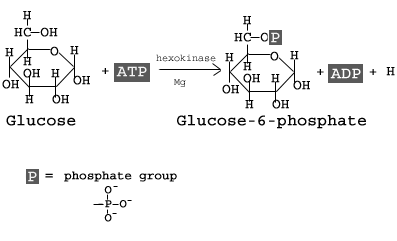
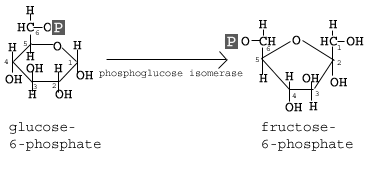 The second reaction of glycolysis is the rearrangement of glucose 6-phosphate (G6P) into fructose 6-phosphate (F6P) by glucose phosphate isomerase (Phosphoglucose Isomerase).
The second reaction of glycolysis is the rearrangement of glucose 6-phosphate (G6P) into fructose 6-phosphate (F6P) by glucose phosphate isomerase (Phosphoglucose Isomerase).

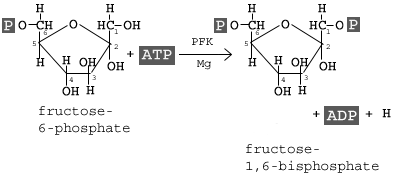 Phosphofructokinase, with magnesium as a cofactor, changes fructose 6-phosphate into fructose 1,6-bisphosphate.
Phosphofructokinase, with magnesium as a cofactor, changes fructose 6-phosphate into fructose 1,6-bisphosphate.

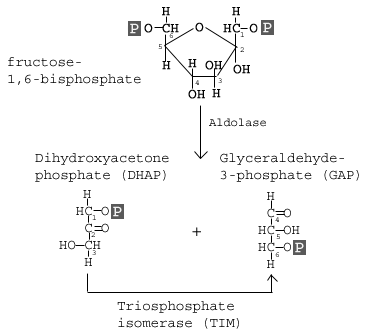 The enzyme Aldolase splits fructose 1, 6-bisphosphate into two sugars that are isomers of each other. These two sugars are dihydroxyacetone phosphate (DHAP) and glyceraldehyde 3-phosphate (GAP).
The enzyme Aldolase splits fructose 1, 6-bisphosphate into two sugars that are isomers of each other. These two sugars are dihydroxyacetone phosphate (DHAP) and glyceraldehyde 3-phosphate (GAP).

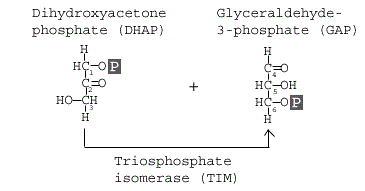
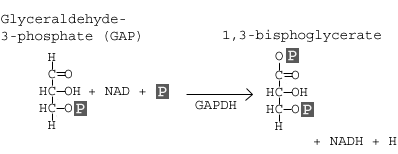
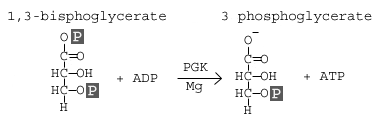
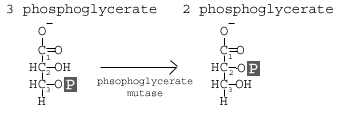

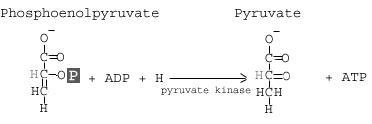

No comments:
Post a Comment